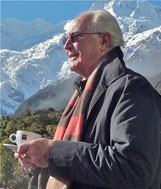All artists are control freaks—and that brings a heap of trouble. Painters know just where a splotch of red must go. Musicians know exactly when to flatten a note. And writers of course know how to cut and slash their paragraphs of prose. The trouble being that when artists go into politics they treat men and women the same way. They know exactly where people should go, and what they should look like, and how to cut and slash Mr and Mrs John Citizen to put them in order.
Hitler was an artist. Stalin took a close interest in what Soviet film directors and composers did. Mao lived with an actress, and her ruthlessness is a byword for the cruel power of despotic courts. All artists have to have things their way—or else. And if you think the fact that Hitler was only an indifferent watercolorist weakens the argument, you couldn’t be more wrong. It is much more likely that it was the gap between his ideals and his achievement—so painfully symbolising the gap between aesthetic ideals and reality on a cosmic scale—which produced the homicidal madness that drove him on. Peoples or cultures or things that didn’t look right had to be destroyed. Nazism was an aesthetic philosophy through and through.
* * *
But aren’t artists usually liberals? Don’t they value freedom of expression? Isn’t liberty the very center of an artist’s being? Not at all. An artist’s primary commitment is egoistic: he is committed to his own freedom to do what he likes. All too seldom is this combined with a democratic vision of the myriad compromises that enable millions of people to live and let live and rub along together—people whose taste is often deplorable, and whose aesthetic sense artists regard with contempt.
“I never pay any heed. I do what I like and not what others like” says Oscar Niemeyer, designer of many of Brasilia’s buildings, and the most famous Brazilian in the world. Now 97, and interviewed by LA Times staff writer Henry Chu a month ago, he went on to add that “Architecture is invention. If you go to Brasilia, you may not like the buildings, but you won’t be able to say you’ve never seen anything like it.”
Mind you, Niemeyer himself lives in a penthouse in busy Rio gazing down on Copacabana Beach. He does not live in Brasilia. And with good reason. For this uncompromising artist Brasilia is where there’s a place for everyone, and everyone has been put in their place by Niemeyer himself—usually around the margins of vast sterile spaces as empty as the moon. His “you’ve never seen anything like it” buildings are the towering symbols of a towering ego. An extrapolation from a drawing-board, Latin monumentalism at its worst, Brasilia’s buildings have wildernesses between them so enormous that prudent pedestrians are well advised to carry food and water in case they get lost on their journeys from one edifice to the next. Marginalised workers of the kind the Brazilian government would like to keep out of sight, ill-dressed, barefoot, and poor, are banished to the outskirts of this utopian city. Indeed, wits have called it “the Final Solution”.
This is unfair. For Niemeyer is very far from being a Nazi or right-winger of any kind, and has always had the interests of the proletariat at heart. According to Mr Chu, he “remains an unreconstructed Marxist, quotes Lenin, laments the fall of the Soviet Union, likes Fidel Castro and detests George W. Bush.” And if membership of the Communist Party is not enough to demonstrate a lively concern for the world’s oppressed, the walls of his Rio office are adorned with rousing slogans: “When misery multiplies and hope flies from the hearts of men, there is only revolution”; “The screwed don’t have a chance.”
At the age of 97 his eyesight is failing, and what Henry Chu calls “his cherished books” are now only available to him on tape. This must be a great privation. For he has always emphasized that architects should read and keep in touch with the world around them. He himself has kept abreast of events for many years, his shelves being “jammed with books on philosophy (Sartre) and politics (Stalin, in French).”
* * *
Brasilia married the architectural arrogance of Oscar Niemeyer to the nationalist zeal and developmental ambitions of President Juscelino Kubitschek de Oliveira. The president was determined that Brazil should have a new capital and “leap 50 years in five”; the architect was determined to “do what I like and not what others like” and be remembered for it. For those who would have to live in this nightmarish product of political and artistic fantasy, a true folie à deux, here was a marriage made in hell. The location—the geographical center of Brazil—could not have been worse chosen by throwing a dart at a map on the wall. Probably a dart would have done better.
It will stand as perhaps the greatest white elephant in the long and mysterious history of building symbolic cities in strange places to satisfy the egos of artists and the longing of political leaders to be memorialised. There is only one other that seems even whiter, more elephantine, more wasteful, and more contemptuous of the citizenry at large: Yamoussoukro, the capital of the Ivory Coast. In this one-time jungle village stands a full-size replica of St Peters’ basilica built by the dictator of the day, Félix Houphouët-Boigny.

 An Australian writer living in Sydney, Roger Sandall is the author of The Culture Cult (2001), a study of romantic primitivism and its effects. His work has appeared in a number of places including Commentary, The American Interest, Encounter, The New Criterion, The American, Sight and Sound, Quadrant, Art International, The New Lugano Review, The Salisbury Review, Merkur, Mankind, Visual Anthropology, and Social Science and Modern Society.
An Australian writer living in Sydney, Roger Sandall is the author of The Culture Cult (2001), a study of romantic primitivism and its effects. His work has appeared in a number of places including Commentary, The American Interest, Encounter, The New Criterion, The American, Sight and Sound, Quadrant, Art International, The New Lugano Review, The Salisbury Review, Merkur, Mankind, Visual Anthropology, and Social Science and Modern Society.